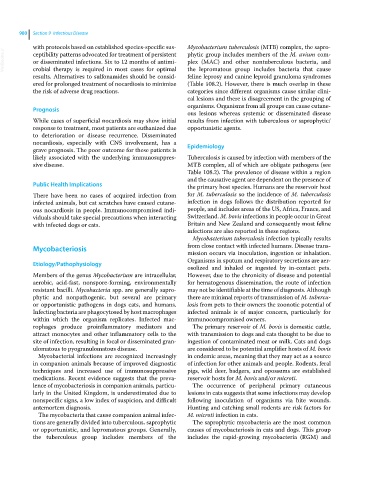Page 1042 - Clinical Small Animal Internal Medicine
P. 1042
980 Section 9 Infectious Disease
with protocols based on established species‐specific sus- Mycobacterium tuberculosis (MTB) complex, the sapro-
VetBooks.ir ceptibility patterns advocated for treatment of persistent phytic group includes members of the M. avium com-
plex (MAC) and other nontuberculous bacteria, and
or disseminated infections. Six to 12 months of antimi-
crobial therapy is required in most cases for optimal
feline leprosy and canine leproid granuloma syndromes
results. Alternatives to sulfonamides should be consid- the lepromatous group includes bacteria that cause
ered for prolonged treatment of nocardiosis to minimize (Table 108.2). However, there is much overlap in these
the risk of adverse drug reactions. categories since different organisms cause similar clini-
cal lesions and there is disagreement in the grouping of
organisms. Organisms from all groups can cause cutane-
Prognosis
ous lesions whereas systemic or disseminated disease
While cases of superficial nocardiosis may show initial results from infection with tuberculous or saprophytic/
response to treatment, most patients are euthanized due opportunistic agents.
to deterioration or disease recurrence. Disseminated
nocardiosis, especially with CNS involvement, has a Epidemiology
grave prognosis. The poor outcome for these patients is
likely associated with the underlying immunosuppres- Tuberculosis is caused by infection with members of the
sive disease. MTB complex, all of which are obligate pathogens (see
Table 108.2). The prevalence of disease within a region
and the causative agent are dependent on the presence of
Public Health Implications the primary host species. Humans are the reservoir host
There have been no cases of acquired infection from for M. tuberculosis so the incidence of M. tuberculosis
infected animals, but cat scratches have caused cutane- infection in dogs follows the distribution reported for
ous nocardiosis in people. Immunocompromised indi- people, and includes areas of the US, Africa, France, and
viduals should take special precautions when interacting Switzerland. M. bovis infections in people occur in Great
with infected dogs or cats. Britain and New Zealand and consequently most feline
infections are also reported in these regions.
Mycobacterium tuberculosis infection typically results
Mycobacteriosis from close contact with infected humans. Disease trans-
mission occurs via inoculation, ingestion or inhalation.
Organisms in sputum and respiratory secretions are aer-
Etiology/Pathophysiology
osolized and inhaled or ingested by in‐contact pets.
Members of the genus Mycobacterium are intracellular, However, due to the chronicity of disease and potential
aerobic, acid‐fast, nonspore‐forming, environmentally for hematogenous dissemination, the route of infection
resistant bacilli. Mycobacteria spp. are generally sapro- may not be identifiable at the time of diagnosis. Although
phytic and nonpathogenic, but several are primary there are minimal reports of transmission of M. tubercu
or opportunistic pathogens in dogs cats, and humans. losis from pets to their owners the zoonotic potential of
Infecting bacteria are phagocytosed by host macrophages infected animals is of major concern, particularly for
within which the organism replicates. Infected mac- immunocompromised owners.
rophages produce proinflammatory mediators and The primary reservoir of M. bovis is domestic cattle,
attract monocytes and other inflammatory cells to the with transmission to dogs and cats thought to be due to
site of infection, resulting in focal or disseminated gran- ingestion of contaminated meat or milk. Cats and dogs
ulomatous to pyogranulomatous disease. are considered to be potential amplifier hosts of M. bovis
Mycobacterial infections are recognized increasingly in endemic areas, meaning that they may act as a source
in companion animals because of improved diagnostic of infection for other animals and people. Rodents, feral
techniques and increased use of immunosuppressive pigs, wild deer, badgers, and opossums are established
medications. Recent evidence suggests that the preva- reservoir hosts for M. bovis and/or microti.
lence of mycobacteriosis in companion animals, particu- The occurrence of peripheral primary cutaneous
larly in the United Kingdom, is underestimated due to lesions in cats suggests that some infections may develop
nonspecific signs, a low index of suspicion, and difficult following inoculation of organisms via bite wounds.
antemortem diagnosis. Hunting and catching small rodents are risk factors for
The mycobacteria that cause companion animal infec- M. microti infection in cats.
tions are generally divided into tuberculous, saprophytic The saprophytic mycobacteria are the most common
or opportunistic, and lepromatous groups. Generally, causes of mycobacteriosis in cats and dogs. This group
the tuberculous group includes members of the includes the rapid‐growing mycobacteria (RGM) and

